Adding a ceremony space to your wedding venue, whether indoors or outdoors, can bring you more weddings. According to The Knot 2017 Real Weddings Study, “ceremonies hosted in a religious institution have dropped significantly, from 41% in 2009 to 22% in 2017.” These couples need to have their ceremonies somewhere and many will consider having them at the same venue as their reception, if the ceremony site fits their vision of their wedding day.
I usually write with couples in mind. Today, I’m offering you, venue owners and managers, this guide because designing the ceremony space starts with you.
As the owner or manager of a reception venue, you know wedding receptions. As a professional wedding officiant with more than a decade of experience, I know ceremonies. I’ve officiated ceremonies ranging from traditional to completely out of the box; in established catering halls, in restaurants, on farms, in parks, on beaches, in converted chapels and warehouses. I’ve seen well-planned spaces and uninspiring spaces that felt like an afterthought. I can tell you what works in a ceremony space and what leaves couples scrambling to solve problems instead of enjoying the start of their wedding celebration.
While you may not be able to incorporate all these ideas, keeping as many as possible in mind when adding a ceremony space to your wedding venue, or renovating an existing ceremony space, will lead to happy memories for your couples and rave reviews for your venue.
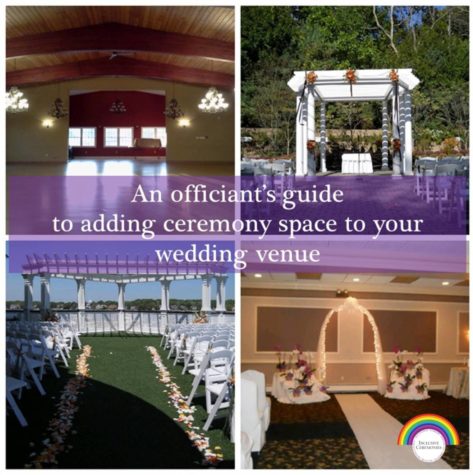
Get your ceremony space report card.
1. How does your ceremony space sound?
This may seem like an odd place to start, but noise is one of the biggest distractions during a wedding ceremony. When choosing the location for your venue’s ceremony space, stand in that space when your venue is in full swing. Then, close your eyes and listen.
For an outdoor ceremony space:
Is it private or will the sounds of other patrons interrupt the ceremony? Is it close enough to the road to hear traffic noise? Will the ceremony space be visible from the road? If motorists can see the ceremony, they’ll often shout and beep to congratulate your couples as they drive past. Consider adding some kind of screening to block the noise and the view from the road.
For an indoor ceremony space:
Can you hear what’s going on in the next room? Can you hear the DJ from the reception down the hall, or the clink of dishes from the kitchen? Is the heat or AC loud? (I once officiated a ceremony at a well-established venue that had two intimate chapels on an upper floor. The one we were in had a closet that housed the building’s cooling system. My couple could barely hear each other say their vows over the sound of the compressors and the guests could barely hear the ceremony at all, despite us using a PA system.) Consider soundproofing your ceremony space.
Will your couples need amplification?
Of course, acoustics will vary depending on the space. I always recommend couples opt for using a PA system for ceremonies that are outdoors with more than 20 guests or in large rooms with high ceilings. However, the PA system is to amplify the voices of ceremony participants. It shouldn’t be necessary to compete with environmental noise.
2. What kinds of wedding ceremonies will your ceremony space accommodate?
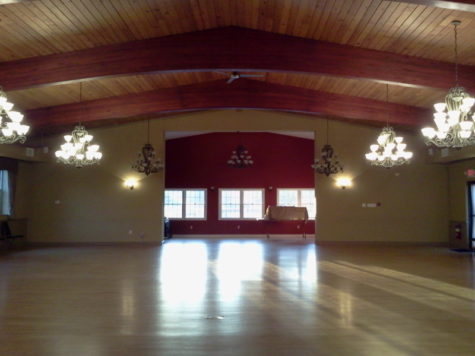
Look at your space from the perspective of a couple planning their wedding—better yet, from the perspective of many different couples. Are you picturing a traditional layout for every ceremony with an aisle down the center, seats on either side, and a small space for the wedding party to stand up front?
If you’re adding a ceremony space to your wedding venue with a rigid (and old-fashioned) idea of what wedding ceremonies look like, you’ll be missing out on couples who don’t fit that mold. Many couples today are moving away from traditional wedding venues, because they’re inspired by Pinterest images of labyrinth weddings, guests seated in a circle around them, and signs encouraging family and friends to mix and mingle, instead of taking sides. Some couples don’t dream of a bride being presented at the altar and prefer the symbolism of walking to each other and meeting in the middle.
Be flexible with the layout of your ceremony space. On your website and social media, show pictures of the different ways your ceremony space can be arranged.
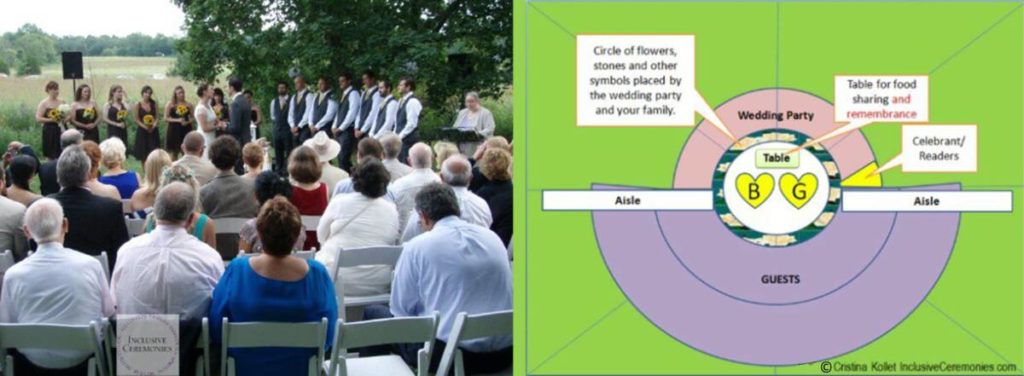
3. How will the space be used during ceremonies?
Typically, your ceremony space will be divided between seating and the space where the ceremony takes place. You’ll want to make sure seated guests have a clear line of site. If guests must peer around corners or roof supports, it makes for a bad experience.
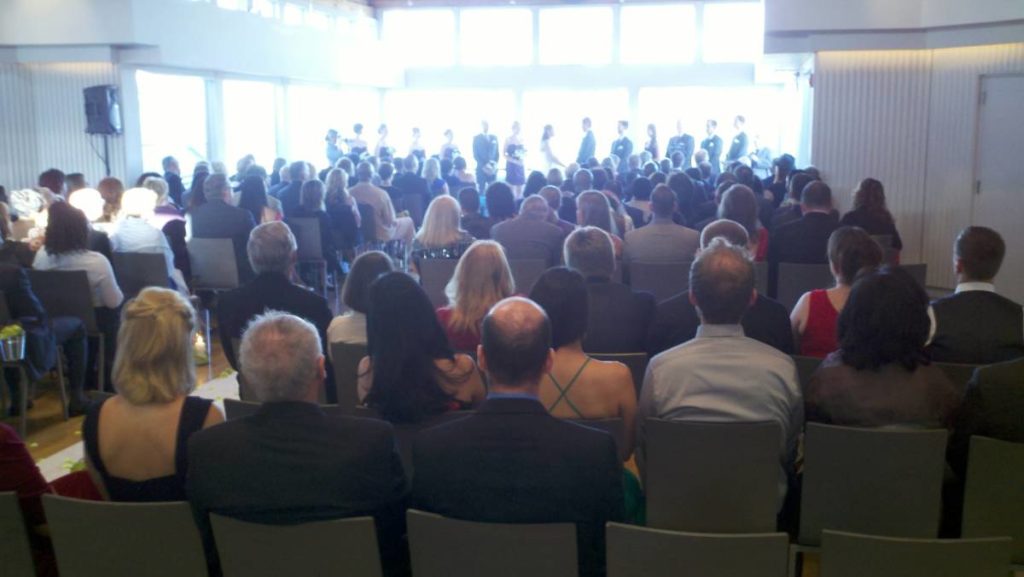
When it comes to how much space is required for the ceremony itself, couples will have different needs depending on their ceremony plans. To cover your bases, I recommend having enough space for a wedding canopy, in some cultures called a mandap or chuppah. Many couples also need a small table for candles, photos, or other ritual items. (Be prepared to provide a small table and tablecloth, as well as votive candles and a lighter).
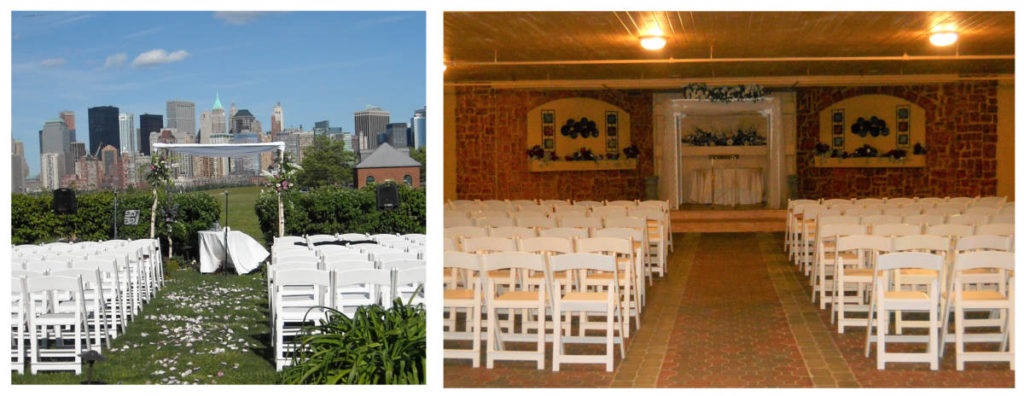
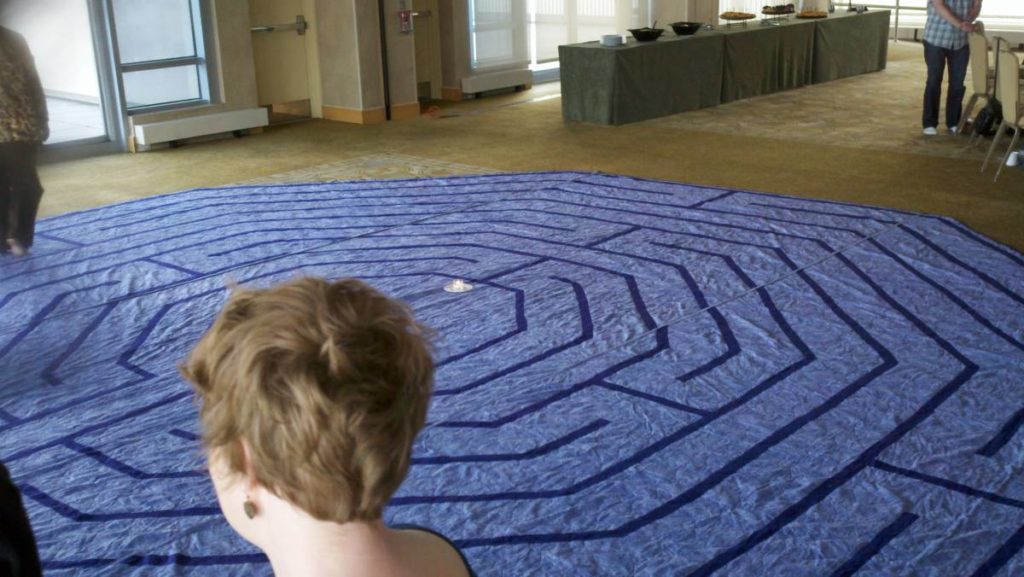
The number of wedding participants occupying the ceremony space will vary. At minimum, you’ll need space for the couple and the officiant. The wedding party will also need a comfortable place to stand. An average wedding party is 5 people on each side, but I’ve seen up to 10 people on each side. If there are readings in the ceremony, readers will need to be able to move easily from the seats to the ceremony space and will also need room to stand.
For outdoor ceremony spaces, remember that women in the wedding party will often be wearing high heels. Give them firm footing so they don’t sink into soft soil or wet grass as they stand for the ceremony.
A word about gazebos as a ceremony space
Gazebos make for a romantic backdrop and great photos of the couple alone. But they often leave everyone asking, where will the wedding party stand during the ceremony? For a gazebo to be a good ceremony space, there needs to be ample space for the couple to stand comfortably, as well as space for the wedding party, officiant, readers, props, etc. Keep that in mind when scoping out the size and shape of your structure.
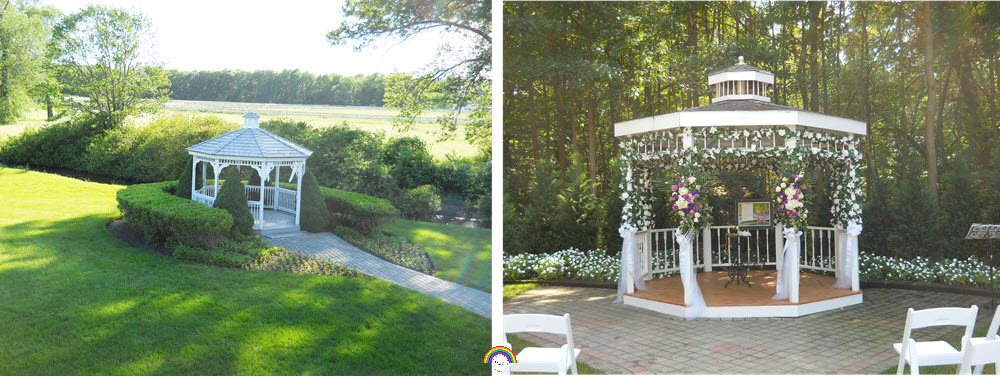
4. Is there enough room in the ceremony space for photographers, musicians and DJs to work?
Your couples will want great wedding photos and you’ll want them too. For that you’ll need room for photographers to move around the ceremony space to get that perfect shot. This means that seating can’t take up the entire area. Try to create a ceremony space with ample guest seating and room around the sides for photographers and videographers to position themselves.
DJs and musicians will also need space to perform. DJs often work from the back but will need line of site with the ceremony area so they can get cues. Musicians are usually posted closer to the ceremony space so they can be seen as well as heard.
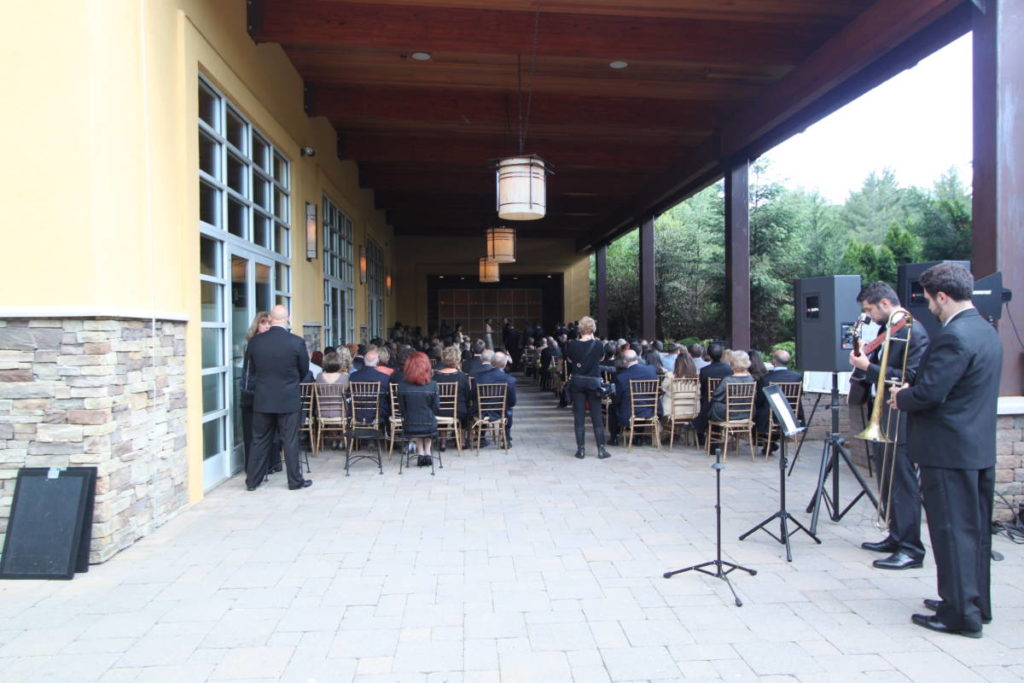
5. Is there enough light and power in your ceremony space?
During the ceremony, officiants, readers, and couples need enough light to read by. If your ceremony space is outside, and you host ceremonies in the early morning or late afternoon, everyone will need enough light for people to move around before and after the ceremony. This may seem like common sense, but I’ve conducted sunset ceremonies that were followed by guests stumbling to the reception in darkness with only the light of their cell phones to guide them. It certainly breaks the mood.
Most wedding ceremonies also include music. So, you’ll want to include ample and convenient power outlets for DJs and musicians. This can be tricky for outdoor spaces that are a distance from your main buildings.
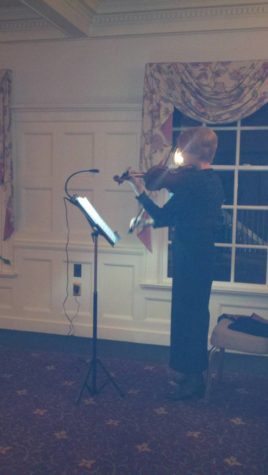
For inside ceremony spaces, I recommend adjustable lighting and power outlets at the front and back of the room to allow for flexibility.
6. How accessible is your ceremony space?
Indoor and outdoor ceremony spaces need to be accessible. This includes stages and structures where you envision ceremonies taking place. When adding a ceremony space to your wedding venue, remember that not all brides and grooms are able-bodied and many couples include grandparents or other family members in their ceremonies who can’t easily climb stairs.
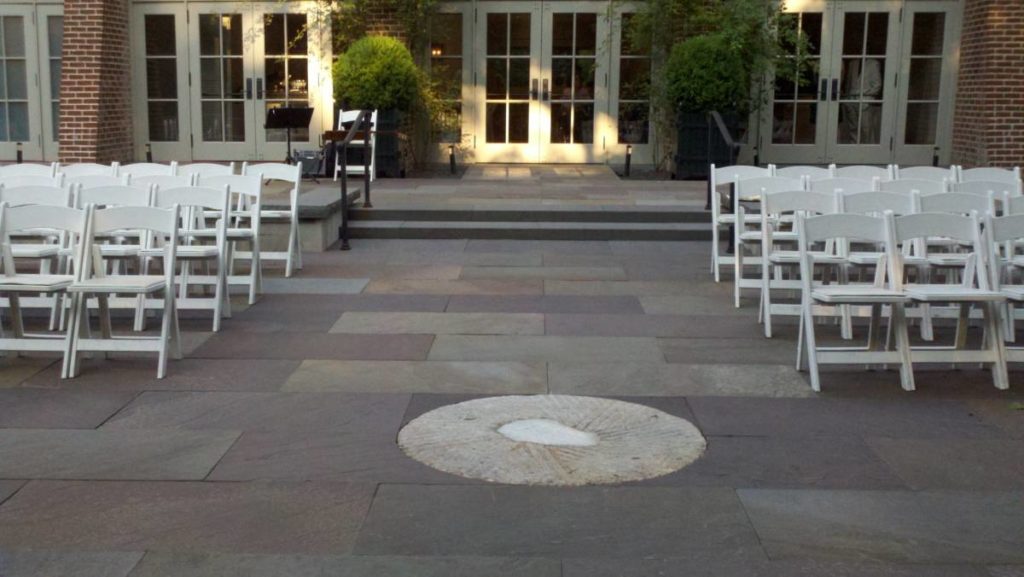
Walking distance to the ceremony space matters.
Another accessibility issue is the distance between the main building and your ceremony space. I’ve seen some lovely outdoor ceremony spaces that were quite a distance from the reception site. If this is the case with your ceremony space, will you have golf carts or some other means to ferry people back and forth? Will they be available before and after the ceremony? Will they be available to guests or just the wedding party? In the hour or so before the guests arrive, there’s often a lot of back and forth on the part of the couple and their family arranging personal touches and checking on final details for the ceremony. Once the guests arrive, and after the ceremony, some may have difficulty with a long walk.
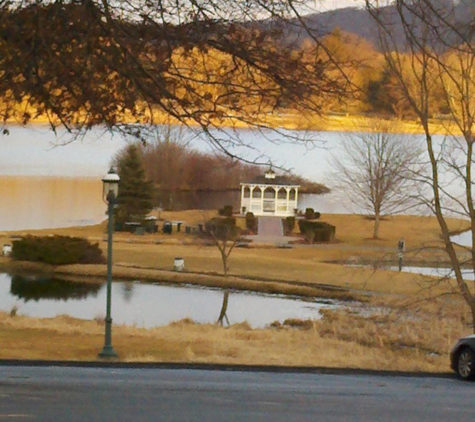
7. Is there a backup for your outdoor ceremony space?
If you offer an outdoor ceremony space, it’s crucial that you offer an equally well appointed indoor space, or a tent. I ask every couple getting married outdoors what their backup plan is. No one wants their wedding plans thrown into chaos by wind or rain.
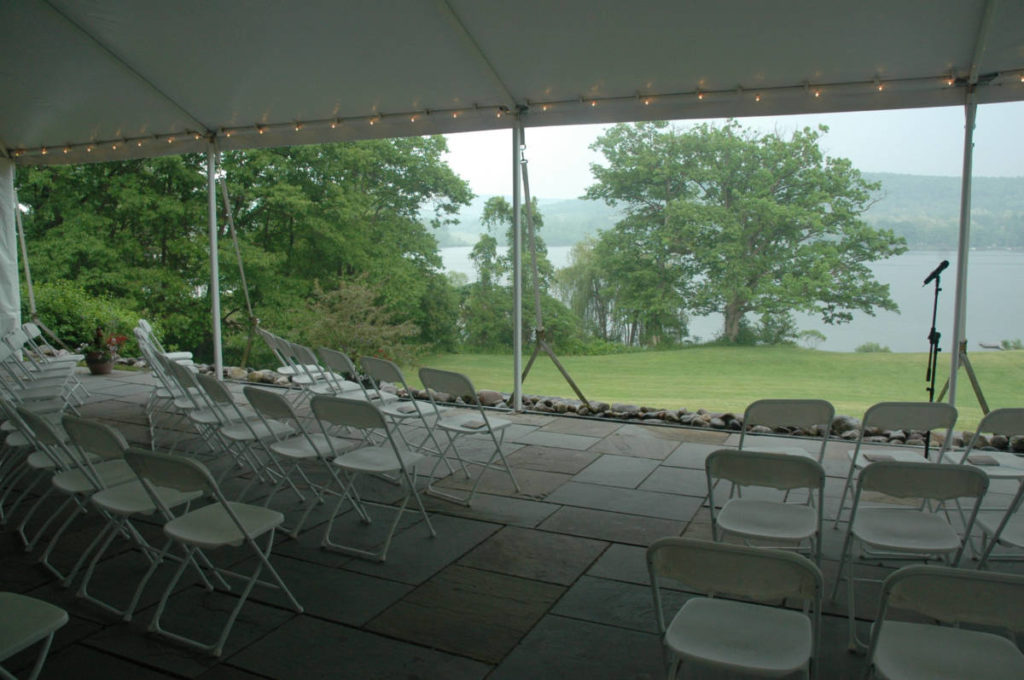
Be prepared to use your backup space. Don’t book it for another event during the time slot that your outdoor space is reserved. Keep in mind that it doesn’t have to be raining during the ceremony timeslot for the backup to be necessary. A switch may be needed if the temperature is too low or high, if it’s been raining earlier and everything is damp, if insects are very active, or if it gets windy.
I can tell you from experience that when a venue refuses to let a couple move their wedding ceremony inside, it casts a shadow over the entire event. The reception may be the bread and butter of your business, but guests are there to see someone they love get happily married. You don’t want their first impression of your venue to be watching from damp seats as their loved ones say their vows under a dripping gazebo. (True story.)
8. Is there someplace for the wedding party to get ready?
If you’re adding a ceremony space to your wedding venue for the first time, remember that couples may need space to get dressed before the ceremony. Some will also need a little time for private reflection or just to catch their breath after the ceremony. The room doesn’t need to be huge. It should be accessible, large enough to fit a few people, well lit, and comfortable. A dedicated space is best. No one wants to put on their wedding dress in a storeroom.
9. Is your staff committed to the couple’s vision of the ceremony?
Most venue staff I’ve met over the years have been welcoming, helpful, and dedicated to fulfilling the couple’s vision of their wedding day. Those that aren’t left a lasting impression. I’ve had the misfortune of encountering a few maître d’s and on-site coordinators, who at the rehearsal—or worse, on the day of the ceremony—created roadblocks for the couple. For example, insisting that the processional be in a traditional order—because that’s how it’s always been done—and overriding the couple’s wishes and careful planning, even when it was presented to them in writing.
I think this is one of the reasons couples, over the years, have been veering away from ceremonies held at traditional venues. Couples want to get married their way. And it’s not hard to give that to them. Make sure your staff is prepared to accommodate non-traditional couples and their ceremonies.
10. Does your venue have restrictions for what can be done during a ceremony or how spaces can be decorated?
Modern weddings often include a variety of new or traditional elements you may or may not be used to seeing. Couples may light candles, share wine, plant a seed, saw wood, stand in a circle of stones or flowers, etc.

Communication with your couples as to what is and isn’t allowed is crucial.
For example, some venues prohibit open flame. That wouldn’t have worked for this wedding ceremony, where fire played a huge symbolic role. In addition to using the fireplace, the couple lit candles and shared that flame with all of the guests, candle to candle.
Your venue may be fine with open flames, but you may not want trampled rose petals staining your white carpet. There’s nothing wrong with having rules for your ceremony space, but it’s important to state those rules up-front, so couples can make an informed decision about booking your venue or using your ceremony space.
Here are just a few of the rules I’ve encountered in my 10+ years of celebrating weddings:
- No open flames (In addition to candles, there are several cultural and religious rituals that require fire.)
- No dirt or sand (This means no planting rituals or sand ceremonies.)
- No scattering of bird seed, bubbles, rose petals, or confetti (This can impact plans the start and end of the ceremony.)
- No amplification
- No flash photography
If you have restrictions in place, make sure couples are aware of them. Providing them with a written list can prevent confusion and disappointment as they plan their ceremony and on their wedding day.
Last tip: Consult a ceremony professional.
No one knows wedding ceremonies like a professional officiant. If you’re in Sullivan county New York, the surrounding area, or northern New Jersey, I’m happy to consult with you about your ceremony space, whether you’re starting from scratch or just looking for ways to make it more attractive to a wider range of couples.
If you’re outside my area, anywhere in the US or Canada, I may be able to recommend a colleague.
Email me at Cris@InclusiveCeremonies.com or call/text me at 973-985-0798.


This is helpful! Thanks for such a great article! Now a wedding ceremony looks easier 😉
Thanks!
Thank you for pointing out that we should look for venues that don’t have any restrictions on how we want to do during our wedding ceremony. My daughter has plans to have her wedding next year and I think we should start looking for a wedding ceremony venue soon. I should probably ask her about certain ceremony decorations and what she plans to do during her wedding ceremony so that I can look for a venue that suits her the most.
While pretty much every aspect of a wedding is optional, from wearing a suit instead of a dress to ditching the flowers to forgoing the wedding cake, there’s one thing you can’t skip: a venue. After all, you’ve got to have somewhere for your friends and family to gather and celebrate.
Thank you for sharing these suggestions.